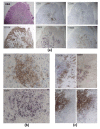Detection of Epstein-Barr Virus in Periodontitis: A Review of Methodological Approaches
- PMID: 33383930
- PMCID: PMC7823867
- DOI: 10.3390/microorganisms9010072
Detection of Epstein-Barr Virus in Periodontitis: A Review of Methodological Approaches
Abstract
Periodontitis, an inflammatory condition that affects the structures surrounding the tooth eventually leading to tooth loss, is one of the two biggest threats to oral health. Beyond oral health, it is associated with systemic diseases and even with cancer risk. Obviously, periodontitis represents a major global health problem with significant social and economic impact. Recently, a new paradigm was proposed in the etiopathogenesis of periodontitis involving a herpesviral-bacterial combination to promote long-term chronic inflammatory disease. Periodontitis as a risk factor for other systemic diseases can also be better explained based on viral-bacterial etiology. Significant efforts have brought numerous advances in revealing the links between periodontitis and Epstein-Barr virus (EBV), a gamma herpesvirus ubiquitous in the adult human population. The strong evidence from these studies may contribute to the advancement of periodontitis research and the ultimate control of the disease. Advancing the periodontitis research will require implementing suitable methods to establish EBV involvement in periodontitis. This review evaluates and summarizes the existing methods that allow the detection and diagnosis of EBV in periodontitis (also applicable in a more general way to other EBV-related diseases), and discusses the feasibility of the application of innovative emerging technologies.
Keywords: EBER-ISH; Epstein–Barr virus; PCR-based methods; detection methods; immunohistochemistry; immunophenotyping; periodontitis.
Conflict of interest statement
The authors declare no conflict of interest.
Figures




References
-
- Papapanou P.N., Sanz M., Buduneli N., Dietrich T., Feres M., Fine D.H., Flemmig T.F., Garcia R., Giannobile W.V., Graziani F., et al. Periodontitis: Consensus Report of Workgroup 2 of the 2017 World Workshop on the Classification of Periodontal and Peri-Implant Diseases and Conditions: Classification and Case Definitions for Periodontitis. J. Clin. Periodontol. 2018;45:S162–S170. doi: 10.1111/jcpe.12946. - DOI - PubMed
-
- WHO What Is the Burden of Oral Disease? [(accessed on 21 October 2020)]; Available online: https://www.who.int/oral_health/disease_burden/global/en/
Publication types
Grants and funding
LinkOut - more resources
Full Text Sources
Other Literature Sources

